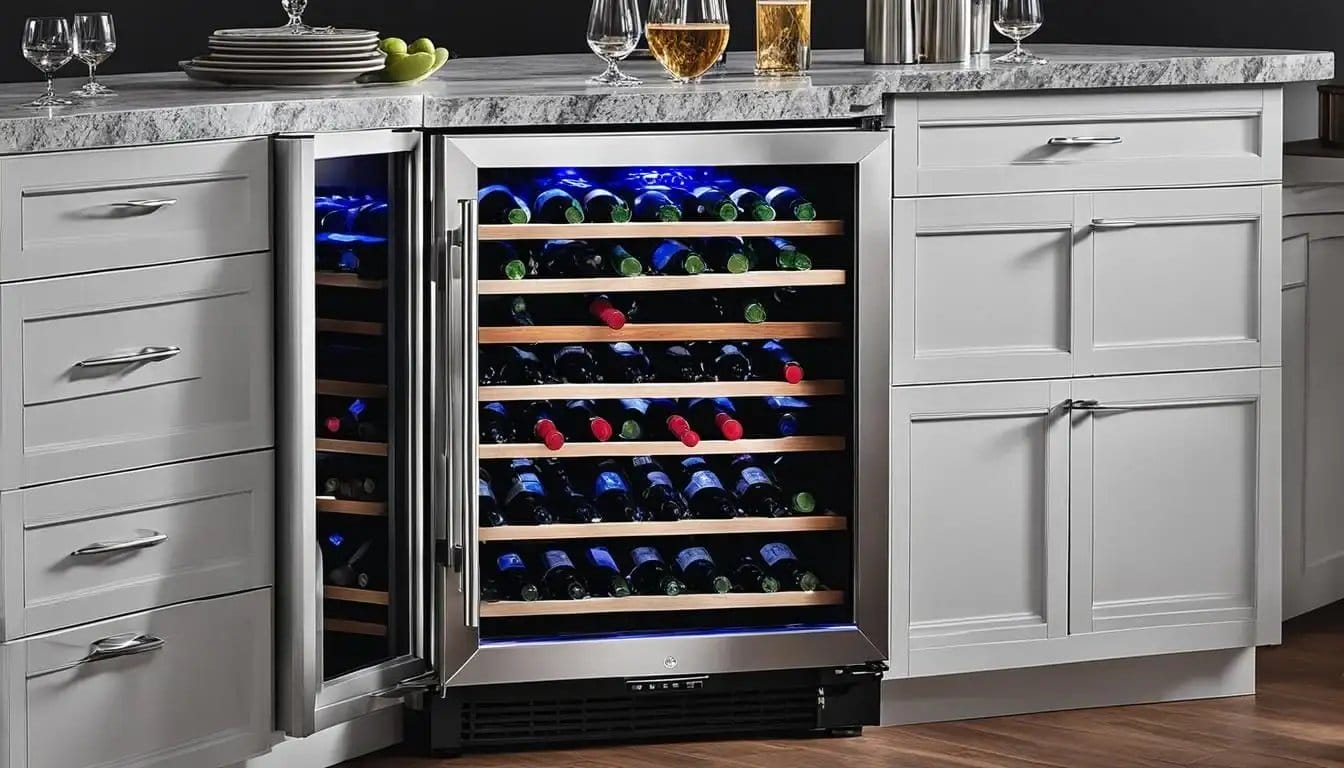In this guide, I will take you through the working mechanism and technology behind wine coolers, so you can make an informed decision before making a purchase.
There are two main types of wine fridges: compressor and thermoelectric. Each operates differently and offers unique benefits for wine storage. Let’s get into the details to understand how these appliances work.
Key Takeaways
- A wine fridge, or wine cooler, is an appliance designed to store and preserve wines at the optimal temperature.
- There are two main types of wine fridges: compressor and thermoelectric.
- Compressor wine fridges use a compression cooling system with a refrigerant, while thermoelectric wine fridges utilize the Peltier effect and do not require refrigerants.
- Understanding how these wine fridges work can help you choose the right one for your needs.
- Continue reading to learn more about the differences, benefits, and features of compressor and thermoelectric wine fridges.

Compressor Cooling System
In a wine fridge, the cooling system plays a crucial role in maintaining the perfect temperature for your wines. Compressor wine fridges utilize a compression cooling system to regulate the interior temperature effectively.
- The cooling process starts with the circulation of a special liquid refrigerant, which flows around the back of the fridge using a compressor. The compressor, powered by electricity, compresses the refrigerant and raises its temperature.
- As the refrigerant reaches a high temperature, it is pushed through metal coils located at the back of the refrigerator. This process releases the heat generated by the compression, allowing the refrigerant to cool down.
- The hot refrigerant gas cools down to the temperature of the kitchen and transforms back into a liquid state. It then flows into the coils inside the wine fridge.
- The main purpose of the liquid refrigerant is to absorb the heat from the surrounding air, effectively cooling the interior of the fridge.
- Once the liquid refrigerant has absorbed enough heat, it flows back to the compressor, repeating the cooling process and maintaining a consistent temperature inside the wine fridge.
- With a compressor cooling system, wine fridges offer precise temperature control, ensuring that your wines are stored at the ideal conditions for preservation and aging.
Thermoelectric Cooling System
Thermoelectric wine fridges harness the power of the Peltier effect to provide efficient cooling.
- This technology utilizes an electric charge that passes through two pieces of metal, generating a heat flux. As a result, one side of the device becomes hot while the other side becomes cold.
- In a thermoelectric wine fridge, the cold side of the device is placed inside the unit to cool the bottles stored within.
- To enhance heat dissipation, these fridges feature a heat sink with aluminum fins and are equipped with a fan for additional cooling. This ensures that the cooling system operates silently and effectively.
The thermoelectric cooling system offers several advantages.
- Firstly, it does not require any refrigerants, making it an eco-friendly option.
- Additionally, the absence of moving mechanical parts makes thermoelectric wine fridges more reliable and durable. The lack of vibrations in the cooling process helps preserve the quality of the wine by minimizing disturbance to the sediments.
- The effectiveness of the thermoelectric cooling system can also be enhanced by proper insulation.
- Adequate insulation prevents temperature fluctuations and maintains a consistent temperature inside the wine fridge, ensuring optimal wine storage conditions.

Compressor And Thermoelectric Wine Fridges
Now we know how their systems work, let’s take a look at what they mean for the wine coolers that use them. Each type has its own unique features and benefits, catering to different needs and preferences.
Compressor Wine Fridges
Compressor wine fridges utilize advanced cooling technology to achieve lower temperatures, making them ideal for long-term storage of wine.
- These fridges work similarly to conventional refrigerators, using a compressor system and a refrigerant to cool the interior.
- Compressor wine fridges provide precise temperature control, allowing you to set the desired temperature for your wines.
- They can reach lower temperatures compared to thermoelectric wine fridges, ensuring optimal conditions for aging your wine collection.
- However, one drawback of compressor wine fridges is their noise level. The operation of the compressor system can generate some noise, which may be a concern for noise-sensitive environments.
Thermoelectric Wine Fridges
Thermoelectric wine fridges, on the other hand, operate silently and are more environmentally-friendly. They do not use refrigerants, making them a greener choice for wine storage.
- These fridges work based on the Peltier effect, using an electric charge to create a heat flux.
- The cold side of the device is inserted into the interior of the wine fridge to cool the bottles, while the hot side dissipates heat through a heat sink with aluminum fins and a fan.
- Thermoelectric wine fridges are ideal for residential settings and shorter-term storage of wine.
- They provide a quiet and efficient cooling system that maintains a consistent temperature for your wines.
Comparing Compressor And Thermoelectric Wine Fridges
Both compressor and thermoelectric wine fridges have their advantages. Factors such as desired temperature range, noise level, and environmental impact. Consider your specific needs and preferences to make your decision.
| Features | Compressor Wine Fridges | Thermoelectric Wine Fridges |
|---|---|---|
| Temperature Range | Lower temperatures for long-term storage | Consistent temperature for shorter-term storage |
| Noise Level | Noisier due to compressor system | Silent operation |
| Environmental Impact | Use of refrigerants | Environmentally-friendly |
| Suitability | Long-term storage of wine and other items | Residential settings and shorter-term storage |
Types And Sizes Of Wine Coolers
There are various types and sizes available to suit different needs. Whether you’re a wine connoisseur or simply enjoy a glass now and then, finding the right wine cooler can enhance your wine storage and ensure that each bottle is served at the perfect temperature.
Let’s explore the different types of wine coolers:
- Countertop Wine Coolers: These compact wine coolers are designed to sit on your kitchen countertop or any other flat surface. They are ideal for small spaces and can typically hold between 6 to 48 bottles of wine. Countertop wine coolers are convenient and easily accessible, making it easy to grab your favorite bottle whenever you want.
- Built-in Wine Coolers: If you’re looking for a more seamless and integrated look in your kitchen, a built-in wine cooler is the way to go. These coolers are designed to be installed into your cabinetry or under the counter, giving your kitchen a sleek and sophisticated appearance. Built-in wine coolers come in a variety of sizes and can accommodate anywhere from 12 to 180 bottles of wine.
- Freestanding Wine Coolers: Freestanding wine coolers are standalone units that can be placed anywhere in your home. They offer flexibility in terms of placement and can be easily moved if needed. Freestanding wine coolers come in a wide range of sizes and can hold anywhere from 12 to 180 bottles of wine.
Aside from the different types, wine coolers also offer various sizes and designs to enhance the functionality and convenience of storing your wine:
- Single-Zone Wine Coolers: These wine coolers provide a consistent temperature throughout the entire unit. They are suitable for those who primarily store one type of wine or prefer a consistent temperature for all their bottles.
- Dual-Zone Wine Coolers: If you enjoy both red and white wines, a dual-zone wine cooler is the perfect choice. These coolers have separate temperature zones, allowing you to store red wines at a slightly higher temperature than white wines. This ensures that each bottle is stored at the ideal temperature for maximum enjoyment.
- Wine Cooler Sizes: Wine coolers vary in size depending on the model. You can find compact wine coolers that hold around 29 bottles, while larger units can accommodate up to 180 bottles. The size you choose depends on the amount of wine you plan to store and the available space in your home.
Some wine coolers also offer additional features such as built-in lights to showcase your collection, special drawers for storing perishable food items, or even built-in freezers to keep ice cubes on hand for serving chilled beverages. Consider these features when selecting a wine cooler that meets your specific needs.

Benefits And Versatility Of Wine Coolers
Wine coolers offer numerous advantages for wine enthusiasts and those seeking to preserve the flavor and quality of their wine.
Maintaining The Optimal Temperature
- Wine coolers ensure that your favorite wines retain their original taste and characteristics.
- They effectively prevent temperature fluctuations that can negatively impact the taste and aging process of wine.
- It provides a stable environment for longer periods of storage and preservation.
Versatility Of Beverage Storage
- These versatile appliances can also be used to store a variety of other beverages, making them suitable for any occasion.
- From sparkling water to non-alcoholic drinks and even sodas, wine coolers provide a cool and convenient space for all your favorite beverages.
- They are particularly useful for entertaining guests, as they allow for easy access and selection of wines, creating a delightful experience for your friends and family.
- In addition to their versatility, wine coolers offer the added benefit of freeing up valuable space in your regular refrigerator.
- By dedicating a specific cooler for your wine collection, you can allocate more room in your main fridge for other perishable items, ensuring efficient storage and organization.
| Benefits of Wine Coolers | Wine Preservation | Versatility |
|---|---|---|
| Preserve the original flavor and quality of wine | Prevent temperature fluctuations | Store a variety of beverages |
| Ensure optimal temperature for long-term storage | Create a stable environment for aging | Easy access and selection of wines |
| Prevent spoilage and spoilage | Free up space in your regular fridge | Convenient storage for entertaining |
Bottom Line
Overall, by understanding the different cooling systems used in wine fridges, namely the compressor and thermoelectric, you can make an informed decision when selecting the right type for your specific needs.
With a wide range of types, sizes, and features available in wine coolers, you can find the perfect fit for your home. Whether you opt for a countertop, built-in, or freestanding wine cooler, a compressor or a thermoelectric wine fridge, single or dual zone, you’ll have an efficient and convenient way to store and enjoy your favorite wines.
Investing in a wine cooler provides numerous benefits. Not only does it help preserve the original flavor and quality of your wine by maintaining the optimal temperature, but it also avoids temperature fluctuations that could affect the taste and aging process.
Happy cooling!
FoodiesFridge









